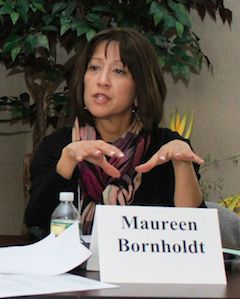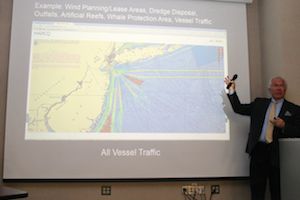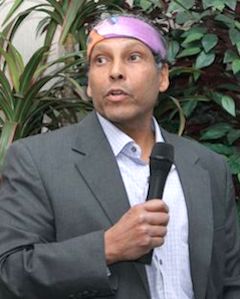The future of the Mid-Atlantic ocean — its health and resiliency, as well as human use and stewardship of this vast natural resource — is the subject of an ambitious planning endeavor by the federal government now underway to “help guide resource conservation and economic development” of the open waters.
Established by an executive order in April 2013 and operating under the auspices of the Bureau of Ocean Energy Management, the Mid-Atlantic Regional Planning Body draws its members from the Navy, the Coast Guard, the Department of Defense, the Department of Homeland Security, the transportation, energy and interior departments, as well as the Environmental Protection Agency and the National Oceanic and Atmospheric
Administration. The RPB also has members representing the six states of the Mid-Atlantic region (New York, New Jersey, Pennsylvania, Delaware, Maryland and Virginia) as well as a representative of the Shinnecock Indian Nation, the only federally recognized tribe in the Mid-Atlantic region.
The group has developed a draft framework for ocean planning that articulates a vision, principles, goals, objectives and actions for regional ocean planning. The RPB released the draft framework in December and has presented the framework in each of the six coastal states during “public listening sessions.”
The listening tour brought the group to downtown Riverhead last week, for two two-and-a-half-hour sessions at the Suffolk County Community College Culinary Arts Center.
 The initial geographic scope and focus of the planning effort will be from the coastline to 200 miles offshore, from the Virginia/North Carolina border north to the N.Y.- Rhode Island border, federal co-leader of the RPB Maureen Bornholdt said.
The initial geographic scope and focus of the planning effort will be from the coastline to 200 miles offshore, from the Virginia/North Carolina border north to the N.Y.- Rhode Island border, federal co-leader of the RPB Maureen Bornholdt said.
Whether the planning effort will include the L.I. Sound remains an open question, Bornholdt said. “Right now we’re silent on the treatment of the L.I. Sound. There’s no consensus yet on how to move forward.”
Several people who attended the afternoon session spoke out to implore the PRB to include the Sound in the planning effort, a federally designated national estuary.
“The Long Island Sound should definitely be included,” Adrienne Esposito, executive director of Citizens Campaign for the Environment, told the RPB members.
“The Sound is particularly relevant,” said Chris Clap, of The Nature Conservancy. “It splits two states and it splits two regional planning bodies.”
According to Kathy Moser of the N.Y. Department of Environmental Conservation, the Northeast Atlantic Regional Planning Body, counterpart of the Mid-Atlantic group, is including the Connecticut waters of the Sound — the Connecticut – New York boundary bifurcates the Sound.
 “We need to stop dividing it,” Esposito said, describing the Sound as a waterway “under attack” by conflicting demands and needs. “There is only one way to really protect the Sound and that’s with a holistic approach.” Otherwise, she said, “It’s like taking care of your heart but not minding what you eat.”
“We need to stop dividing it,” Esposito said, describing the Sound as a waterway “under attack” by conflicting demands and needs. “There is only one way to really protect the Sound and that’s with a holistic approach.” Otherwise, she said, “It’s like taking care of your heart but not minding what you eat.”
Similarly others in the audience advocated including the island’s bays and estuaries in the planning effort, but Bornholdt said the purpose of the planning body was more “outward facing,” noting that the government already has good data on the region’s bays, estuaries and wetlands through existing programs.
The RPB’s “desired future state for the Mid-Atlantic Ocean” — is an “ocean where safe and responsible use and stewardship support healthy, productive, resilient, and treasured natural and economic ocean resources that provide for the wellbeing and prosperity of present and future generations,” according to the draft framework.
The goals of ocean planning are twofold, according to the draft framework: first, to promote the health and integrity of the ocean through conservation, protection, enhancement, and restoration; and second, to plan and provide for existing and emerging ocean uses in a sustainable manner that reduces conflicts, improves efficiency and regulatory predictability, and supports economic growth.
The Mid-Atlantic supports a wide variety of commercial activity, including traditional uses such as marine transportation, commercial fishing, sand and gravel mining, and energy pipelines. Proper planning is needed for the continuation of those uses, focusing on sustainability of the resources on which they relay, Bornholdt said. Planning is also necessary to guide the development of emerging ocean uses, such as offshore wind farms, she said.
“It’s good to have a plan, but if you don’t back it up with the proper architecture and the underlying regulatory authority to govern use and development, then having a plan is almost moot,” said Jeremy Samuelson, executive director of Concerned Citizens of Montauk. “What are the likely outcomes of this? Something that looks like a plan or something that looks like zoning?”
Samuelson said the government should have “simple, sensible guidance as to where specific activities are allowed.”
“Once a plan is in place, federal regulatory authorities would have to comply with it, said National Resources Defense Council policy analyst Ali Chase.
 “While we’re all sitting around talking about plans, things are going on that we’re powerless to stop,” Concerned Citizens of Montauk board member Rav Friedel said. He called for a moratorium on new uses, “so decisions can be made based on science rather than the demands of big energy.”
“While we’re all sitting around talking about plans, things are going on that we’re powerless to stop,” Concerned Citizens of Montauk board member Rav Friedel said. He called for a moratorium on new uses, “so decisions can be made based on science rather than the demands of big energy.”
Conflicting demands on ocean resources is a growing issue and one that often seems to overwhelm the existing regulatory framework, noted Esposito.
John Davi of Port Jefferson Station, the only commercial fisherman to attend the April 7 afternoon session, asked who on the planning body represents the commercial fishing industry. Bornholdt answered that NOAA assistant regional administrator Kevin Chu and a representative of the Mid-Atlantic Fishery Management Council filled that role. She explained that as an entity established by executive order, rather than by an act of congress, membership by nongovernmental entities is prohibited. Davi left in the middle of the meeting.
Shinnecock Indian Nation advisor Salvatore Ruggiero lamented the lack of attendance by fishermen, something he said he didn’t understand. “They need to be at the table,” he said.
Notice of the Riverhead listening sessions was sent to stakeholders by email and via a listserv, Michael Snyder of the N.Y. Department of State, said after the meeting. Notice was not given to the news media for public dissemination, he acknowledged. A host of nongovernmental organizations were represented in the audience, including: The Natural Resources Defense Council, the Peconic Estuary Program, Citizens Campaign for the Environment, The Nature Conservancy, Sea Grant, Concerned Citizens of Montauk, the Surfrider Foundation and the N.Y. Aquarium.
According to the Mid-Atlantic Regional Planning Body’s website: A 2010 executive order established a national ocean policy to guide the protection, maintenance, and restoration of America’s oceans and coasts. The policy requires federal agencies to work in a more coordinated, goal-oriented framework with states, tribes, and stakeholders. The policy also calls for the creation of Regional Planning Bodies to coordinate and implement regional ocean planning with state, federal, tribal, and fishery management council representatives. The Mid-Atlantic RPB was formally established in April 2013. “It will leverage existing efforts underway by states and regional entities, and engage stakeholders and technical experts at every key step.”
The survival of local journalism depends on your support.
We are a small family-owned operation. You rely on us to stay informed, and we depend on you to make our work possible. Just a few dollars can help us continue to bring this important service to our community.
Support RiverheadLOCAL today.































